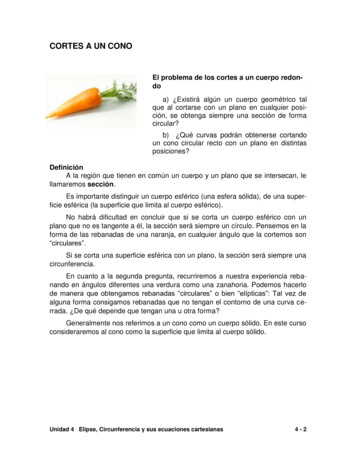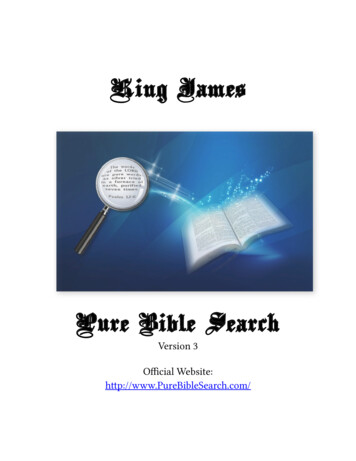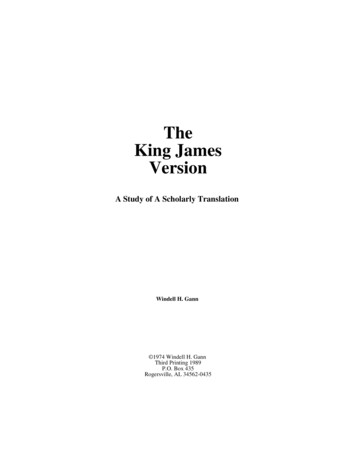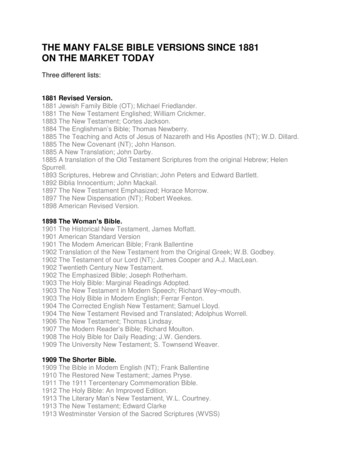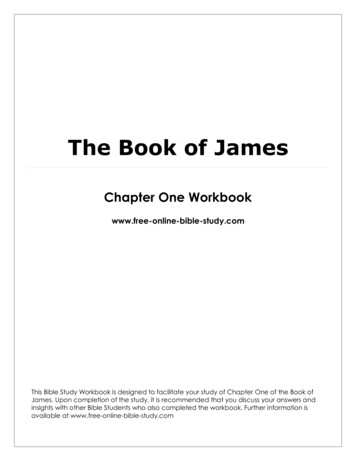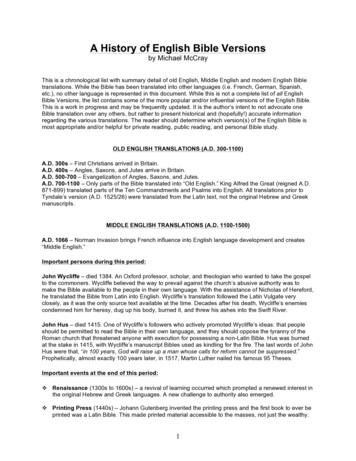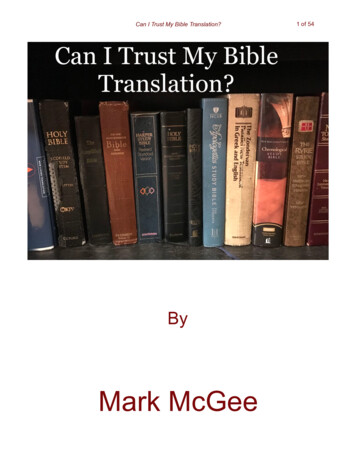
Transcription
Notes onJames2 0 2 2 E d i t i o nDr. Thomas L. ConstableWRITERThe writer of this epistle was evidently the half-brother of our Lord JesusChrist (Gal. 1:19) and the brother of Jude, the writer of the epistle thatbears his name (cf. Matt. 13:55).1 This was the opinion of many of theearly church fathers and writers.2 This James was not the brother of theApostle John, the son of Zebedee, who suffered martyrdom early in thehistory of the church (Mark 1:19; Acts 12:2). Neither was he the son ofAlphaeus (Mark 3:18) or the father of Judas (Luke 6:16). He was theleading man in the Jerusalem church who spoke at the Jerusalem Council(Acts 15:13-21; cf. 12:17; 21:18; 1 Cor. 15:7). Some commentatorsbelieved that the similarities in the Greek of this epistle and James' speechin Acts 15 support his identification as the writer.3 The fact that the writerwrote this epistle in very good Greek should not rule this James out. Hewould have been fluent in both Aramaic and Greek as a gifted Galilean.RECIPIENTSThe recipients of this letter were the Jewish Christians of the Diaspora,Jews who had scattered from Palestine and had come to faith in Christ1SeeDonald A. Carson and Douglas J. Moo, An Introduction to the New Testament, pp.621-26; Douglas J. Moo, The Letter of James, (2000), pp. 9-20.2E.g., The Ecclesiastical History of Eusebius Pamphilus, pp. 78-79 (bk. 2, ch. 23). Eusebiuslived about A.D. 265-340. For fuller discussion, see Peter H. Davids, The Epistle of James,pp. 7-9; Ralph P. Martin, James, pp. xxxiii-lxi; and Joseph B. Mayor, The Epistle of St James,pp. i-lxv.3E.g., D. Edmond Hiebert, James, pp. 17-18; Walter W. Wessel, "The Epistle of James," inThe Wycliffe Bible Commentary, p. 1429.Copyright Ó 2022 by Thomas L. Constable
2Dr. Constable's Notes on James2022 Edition(1:1). Several Jewish references in the book support the claim that a Jewwrote it to other Jews (e.g., 1:18; 2:2, 21; 3:6; 5:4, 7).DATEJosephus wrote that James died in A.D. 62.1 Josephus did not record thedate, but he identified James' death with that of Portius Festus who diedin A.D. 62. So James wrote this letter before that date. Manycommentators believed that James' lack of reference to the JerusalemCouncil (A.D. 49) suggests that he wrote before that meeting. This is aweak argument, however, since the issues that James dealt with in thisepistle are different from those that the Jerusalem Council discussed.Reference to the Jerusalem Council in this letter would have beenunnecessary. According to tradition, however, James wrote early in thehistory of the Christian church.It appears to many scholars and to me that the epistle of James wasprobably the first divinely inspired one and that James composed it in themiddle or late 40s, perhaps A.D. 45-48.2 A few believe that he wrote evenearlier, perhaps as early as A.D. 34 or 35.3 Many scholars have taken James'lack of references or allusions to other inspired New Testament epistles asadditional support for this position. I believe there is no substantial reasonto doubt the traditional early date.4PLACE OF WRITINGSince James lived in Jerusalem for most if not all of his Christian life, thatcity seems to be the most likely place of writing.1FlaviusJosephus, Antiquities of the Jews, 20:9:1. Josephus was a Jewish general in theRoman army who later became the governor of Galilee in the late first century A.D.2See Arno C. Gaebelein, The Annotated Bible, 4:2:9-10; Donald W. Burdick, "James," inHebrews-Revelation, vol. 12 of The Expositors Bible Commentary, p. 162; Wessel, p. 1429;Moo, pp. 25-26.3Zane C. Hodges, "The Epistle of James," in The Grace New Testament Commentary,2:1100.4For thorough discussion of the date, see Mayor, pp. cxliv-clxxvii; or Davids, p. 4, whocatalogued the opinions of 64 modern commentators regarding the date of composition.
2022 EditionDr. Constable's Notes on James3"All the evidence left of his life suggests that he clungthroughout his Christian life to Jerusalem and did notundertake such missionary labours as would entitle him to thedesignation of Apostle."1According to Eusebius (c. A.D. 263-340), the scribes and Pharisees threwJames down from the pinnacle of the temple, which was 170 feet abovethe Kidron Valley below, then stoned him, and a fuller (a first-century clothor clothes-washer) beat out his brains with a club.2SPECIAL FEATURES" as contemporary rhetorical criticism has pointed out, theNT documents were almost certainly intended for publicreading in the churches. Thus James's letter is basically aspeech or sermon, cast in written form."3There are several unique features of this epistle. It contains no referencesto any of the specific individuals among the original recipients. There is noconcluding benediction. And there are very many imperatives in the letter,about one for every two verses."No other New Testament book contains such a concentrationof commands."4There are many figures of speech and analogies, probably more than in allof Paul's epistles.5 James also alluded to over 20 Old Testament books. Hereferred to many Old Testament characters including Abraham, Rahab, Job,and Elijah—as well as to the Ten Commandments and the Law of Moses.One commentator observed that this book "has a more Jewish cast thanany other writing of the New Testament."6There are many references to nature in James. This was characteristic ofthe Jewish rabbis' teaching in James' day as well as the teaching of the1F.Rendall, "The Epistle to the Galatians," in The Expositor's Greek Testament, 3:156.p. 77 (bk. 2, ch. 23).3Hodges, p. 1101.4Kenneth G. Hanna, From Gospels to Glory, p. 409.5J. Ronald Blue, "James," in The Bible Knowledge Commentary: New Testament, p. 816.6Mayor, p. ii.2Eusebius,
4Dr. Constable's Notes on James2022 EditionLord Jesus Christ. There are also many allusions to Jesus' teaching in theSermon on the Mount—more than in all the letters of the New Testamentcombined, according to G. Campbell Morgan.1 Yet there are only tworeferences to Jesus (1:1; 2:1), which was one factor that led Martin Lutherto question whether this book was worthy of being in the New Testament.2" in his [Luther's] preface to the New Testament of 1522James was stigmatized as 'an epistle of straw.' Once Lutherremarked that he would give his doctor's beret to anyone whocould reconcile James and Paul."3Luther's problem was that he thought James was writing about becominga Christian (justification). James was really writing to Christians about howto live the Christian life (sanctification)." perhaps no greater mistake can be made in interpretingJames than to read his letter in the light of Paul. James, wemust remember, is writing (we have argued) before Paul hadwritten any of his letters "4The margin of the Nestle Greek Testament version of James identifies 38references to statements in Matthew. Both books seem to have beenwritten about the same time, namely, in the late 40s A.D."Both writers [Matthew and James] seem to have to do with asimilar type of community "5Leading themes in James include perfection, wisdom, and the piety of thepoor.61G.Campbell Morgan, The Unfolding Message of the Bible, p. 382. See Virgil V. Porter Jr.,"The Sermon on the Mount in the Book of James, Part 1," Bibliotheca Sacra 162:647 (JulySeptember 2005):344-60; idem, "The Sermon on the Mount in the Book of James, Part2," Bibliotheca Sacra 162:648 (October-December 2005):470-82. See the charts in TheBible Knowledge Commentary: New Testament, pp. 817 and 818, for James' referencesto nature and the Sermon on the Mount.2William Barclay, The Letters of James and Peter, p. 28.3Roland H. Bainton, Here I Stand, p. 259.4Moo, p. 83.5E. M. Sidebottom, James, Jude, 2 Peter, p. 14). See also Davids, pp. 47-48, for a chartof similarities between verses in James and those in the Synoptic Gospels, and Martin, pp.lxxv-lxxvi, for common links between Matthew and James.6Martin, pp. lxxix-lxxxvi.
2022 EditionDr. Constable's Notes on James5"As soon as we read through the letter of James we say toourselves, 'This man was a preacher before he was a writer.'"1"In style it reminds one now of the Proverbs, now of the sterndenunciations of the prophets, now of the parables in theGospels."2" one of the characteristics of the Epistle is thestraightforward, transparent way in which things are put."3"The Epistle of James is without doubt the least theological ofall NT books, with the exception of Philemon."4"Three doctrines come to the surface more often than anyothers, and of these the most prominent is the doctrine ofGod. In keeping with the ethical nature of the epistle is therepeated stress on the doctrine of sin. And, surprisingly, thethird most prominent theological theme is eschatology."5"The epistle of James is no more anti-Pauline than is theSermon on the Mount."6"Is there not a significant appropriateness that Hebrews, whichstresses faith, should be seconded by James, insisting on goodworks?—that First Peter, the epistle of future hope, should befollowed by second Peter, which is all about present growth ingrace?—that the epistles of John, with their emphasis on love,should be balanced by Jude, with its call to contend for thefaith? And is it not an obviously perfective finale, that thisprogressive lesson in matching faith by good works, futurehope by present growth, and brotherly love by contending forthe faith, should be crowned by the characteristic promise ofthe Apocalypse—'To him that overcometh'?"71J.Alec Motyer, The Message of James, p. 11.p. i.3W. E. Oesterley, "The General Epistle of James," in The Expositor's Greek Testament,4:425.4Burdick, p. 164.5Ibid., pp. 164-65.6George M. Stulac, James, p. 16.7J. Sidlow Baxter, Explore the Book, 6:283.2Mayor,
Dr. Constable's Notes on James62022 EditionPURPOSE"The design of the Epistle is on the one hand to encouragethose to whom it is addressed to bear their trials patiently, andon the other hand to warn them against certain errors ofdoctrine and practice."1"The purpose of this potent letter is to exhort the earlybelievers to Christian maturity and holiness of life. This letterdeals more with the practice of the Christian faith than with itsprecepts. James told his readers how to achieve spiritualmaturity through a confident stand, compassionate service,careful speech, contrite submission, and concerned sharing. Hedealt with every area of a Christian's life: what he is, what hedoes, what he says, what he feels, and what he has."2"The chief aim of the Epistle is to strengthen the faith andloyalty of the Jewish Christians in the face of persecution fromrich and overbearing Jews who were defrauding and oppressingthem."3OUTLINEI.II.Introduction 1:1Trials and true religion 1:2-27A.The value of trials 1:2-111.2.3.4.B.The options in trials 1:12-181.2.1Mayor,The proper attitude toward trials 1:2The end product of trials 1:3-4Help in adopting this attitude 1:5-8The larger view of circumstances 1:9-11The ultimate end of trials 1:12The source of temptation 1:13-14p. cxxviii.p. 818.3A. T. Robertson, Word Pictures in the New Testament, 6:6.2Blue,
2022 Edition3.4.C.TheTheTheTheimproper response 1:19-20essential response 1:21complete response 1:22-25external behavior 1:26-27Partiality and vital faith ch. 2A.The problem of favoritism 2:1-131.2.3.4.5.6.B.TheTheTheTheTheThenegative command 2:1present improper practice 2:2-4inconsistency of favoritism 2:5-7Christian's duty 2:8-9significance of partiality 2:10-11implication of our own judgment 2:12-13The importance of vital faith 2:14-261.2.3.4.5.6.IV.The progress of temptation 1:15The goodness of God 1:16-18The proper response to trials 1:19-271.2.3.4.III.Dr. Constable's Notes on JamesJames' assertion 2:14James' illustration 2:15-16James' restatement of his point 2:17An objection 2:18James' rebuttal 2:19-23James' final argument 2:24-26Speech and divine wisdom ch. 3A.Controlling the tongue 3:1-121.2.3.4.5.B.The negative warning 3:1The reason for the warning 3:2Examples of the danger 3:3-8The uncontrollable nature of the tongue 3:7-8The inconsistency of the tongue 3:9-12Controlling the mind 3:13-181.The importance of humility 3:137
Dr. Constable's Notes on James82.3.V.Conflicts and humble submission ch. 4A.Interpersonal and inner personal tensions 4:1-101.2.3.4.B.C.source of conflict 4:1explanation of the conflict 4:2-3nature of the choice 4:4-5resources to choose right 4:6-10The self-centered person 4:13-16The concluding exhortation 4:17Money and patient endurance 5:1-18A.Warnings for the rich 5:1-61.2.3.B.C.The introduction of the problem 5:1The corrosive effect of wealth 5:2-3The misuse of wealth 5:4-6The proper attitude 5:7-121.2.3.The exhortation to be patient 5:7-9Examples of endurance 5:10-11The evidence of patience 5:12The proper action 5:13-181.2.3.VII.TheTheTheTheSelf-exaltation 4:11-12Self-reliance 4:13-171.2.VI.The importance of graciousness 3:14-16The importance of loving peace 3:17-18The way of release 5:13The prescription for help 5:14-16The power of prayer 5:17-18The way back to living by faith 5:19-202022 Edition
2022 EditionDr. Constable's Notes on James9MESSAGEThe Book of James teaches us that faith in God should result in behaviorthat is in harmony with God's will. The theme of the book is "living by faith"or "spiritual maturity." James is like a series of five sermons reworked forpublication (cf. Hebrews and Jude).James' concern was Christian behavior (ethics) as expressive of Christianbelief (doctrine). James hardly mentioned most of the fundamentalChristian doctrines in this book. His preeminent concern was the practiceof Christianity, the manifestation of salvation in shoe leather.The teaching of this epistle has its roots in Jesus' teaching in the Sermonon the Mount. That was, of course, His great ethical discourse. James madeno fewer than 18 references or allusions to Matthew 5—7 in his epistle.James is an exposition of the main ideas in that sermon. Jesus presentedthree great revelations in the Sermon on the Mount that James expoundedin this book:First, Jesus spoke of the behavior of believers. In Matthew 5:20, Jesus said:"unless your righteousness far surpasses that of the scribes and Pharisees,you will not enter the kingdom of heaven."1 Jesus was speaking of howrighteous behavior manifests itself. James commented on five behaviors inwhich his readers needed to demonstrate their righteousness. By the way,when James and Jesus spoke of righteousness, they usually meant rightconduct. This is the more common Old Testament use of the word. Paul,on the other hand, usually used righteousness when referring to one's rightcondition, namely, the believer's standing in Christ.Second, Jesus clarified the believer's goal. In Matthew 5:48, Jesus said:"you shall be perfect, as your heavenly Father is perfect." This maturityinto the image of Christ is God's goal for every Christian (cf. Eph. 4:13). Indealing with each of the five behaviors that he selected, James clarified thegoal that the believer should bear in mind and to which he or she shouldpress.Third, Jesus illuminated the method by which the believer can reachmaturity (perfection) in the way he or she behaves. In Matthew 6:1, Jesussaid: "Take care not to practice your righteousness in the sight of people,1Quotationsfrom the English Bible in these notes are from the New American StandardBible (NASB), 2020 edition, unless otherwise indicated.
Dr. Constable's Notes on James102022 Editionto be noticed by them." Jesus taught that believers should live to obtainGod's approval rather than the approval of their fellowmen. Jamesexplained what that means in each case for the five behaviors that he dealtwith in this epistle. He showed how to live for God's approval rather thanfor the approval of people.These three great revelations by Jesus in the Sermon on the Mountcontribute the hidden framework on which James hung his challenges to hisreaders. All of these challenges deal with spiritual immaturity. The Sermonon the Mount is like the framework of a house. James covered theframework with his exposition, and what he said is connected to what Jesussaid.In chapter 1 the behavior dealt with is trials: the difficult experiences thatevery believer encounters in life. James revealed that God's goal forbelievers in allowing us to experience trials is personal maturity. He alsoexplained that the method by which we attain this goal is by patientlyaccepting our trials as from God.In chapter 2 the behavior in view is prejudice. God's goal for believers, whichprejudice tends to thwart, is love for all people. The method by which wecan reach this goal in God's plan is by exercising genuine faith in God. Jamesexplained the relationship between prejudice and faith in this chapter.In chapter 3 the behavior is our speech. God's goal is that we bless otherswith our speech: God Himself, and all other people. The method is to receiveand use wisdom from God.In chapter 4 the behavior is conflicts in interpersonal and inner personalrelationships. God's goal is that we maintain peace with others, and Hismethod is submission to God.In chapter 5 the behavior is our use of money. The goal is that we usemoney to serve others rather than hoarding it for ourselves. The methodof attaining this goal is twofold: patience with God, and prayer to God."His [James'] short, abrupt paragraphs have been likened to astring of pearls—each is a separate entity in itself."11Wessel,p. 1430.
2022 EditionDr. Constable's Notes on James11I would state the application of this epistle with the following twoaffirmations:First, the life of faith is a life of peril. If we would achieve God's goal ofrighteous behavior we must overcome the obstacles that stand in our way.Our opposition comes from three sources, each of which James dealt within his exposition of each behavior.We must challenge the spirit (popular philosophy) of our world. The worldsystem says: Avoid trials (ch. 1). Give preference to those who can helpyou (ch. 2). Promote yourself by what you say (ch. 3). Demand your rights(ch. 4). Grab all the money you can (ch. 5).James wrote that we must also deny the lusts of our flesh. The flesh is thesecond source of peril that we face. By the way, the New Testament writersused the word flesh (Gr. sarx) in three ways, one literal and twometaphorical. Literally it refers to our bodies. Metaphorically, it refers to allthat we were in Adam before our regeneration, or it refers to our humannature that is sinful. Here James was speaking of our sinful human nature.The flesh says: Indulge yourself and give in to the temptations that oftenaccompany trials (ch. 1). Love yourself rather than others (ch. 2). Glorifyyourself rather than promoting others and God (ch. 3). Assert yourselfrather than submitting to God (ch. 4). Serve yourself rather than servingothers (ch. 5).James also cautioned us to resist the devil, the third source of oppositionto God's work of producing righteousness in our conduct. Satan says: Godhates you, and your trials are an evidence of that (ch. 1). Satan says: Godis withholding good things from you that you would surely receive if youshowed favoritism to those who are able to favor you (ch. 2). Satan says:God has abandoned you, so you need to speak up for yourself (ch. 3). Satansays: God will not defend you, so you must be more self-assertive (ch. 4).Satan also says: God will not provide for you, so you must hoard yourmoney rather than distributing it as a good steward (ch. 5).The second affirmation that summarizes the application of the teaching ofthis epistle is this: The life of faith is a life of power as well as a life of peril.With each of the five major problems that James dealt with, we can seethat the life of faith is more powerful than the life of unbelief.
12Dr. Constable's Notes on James2022 EditionFaith is superior to the spirit (philosophy) of our world. It is stronger thanthe lusts of our flesh. It is stubborn against the attacks of the devil.Therefore we should continue to live by faith. James' great theme is thatwe need to keep trusting and obeying God. As we began the Christian lifeby faith, so we need to continue to live by faith day by day, rather thanreverting to our former habit of trusting in ourselves and behaving likeunbelievers.11Adapted40.from G. Campbell Morgan, Living Messages of the Books of the Bible, 2:2:123-
2022 EditionI.Dr. Constable's Notes on James13INTRODUCTION 1:1The writer first identified himself for the original recipients of this epistle,and greeted them, in order to introduce himself to them.James (lit. Jacob) was probably the half-brother of the Lord Jesus Christ.He evidently became a believer late in Jesus' earthly ministry (cf. John 7:5;1 Cor. 15:7). He became the leader of the church in Jerusalem early in itshistory (Gal. 2:9; Acts 15:13-21)."Apart from Paul and Peter, no figure in the church of the firstdays plays a more substantial part upon the historic andlegendary stage than James, first Bishop of Jerusalem."1James described himself simply as a bond-servant (Gr. doulos) of God andof the Lord Jesus Christ. Only he and Jude, another half-brother of theLord, described themselves simply as bond-servants in their epistles. Thisprobably indicates that they were so well known in the early church thatthey did not need to describe themselves in more detail.2 James did notrefer to himself as Jesus' brother or as the church's leader. He evidentlypurposed not to know Jesus after the flesh (2 Cor. 5:16) but only as hisLord and God. Being a bond-servant of God was his most importantrelationship (cf. Rom. 1:1; Phil. 1:1; Titus 1:1; 2 Pet. 1:1; Jude 1; Rev. 1:1).He placed Jesus on an equal level with God by saying that he was the bondservant of both God and the Lord Jesus Christ.The term bond-servant did not carry the degrading connotation in the firstcentury that it does today. In the Septuagint, doulos described Israel'sgreat leaders who occupied positions of privilege and honor (e.g., Moses[Deut. 34:5; et al.]; David [2 Sam. 7:5; et al]; and the prophets [Jer. 7:25;44:4; Amos 3:7]).3 By using this word James was proudly asserting thathe belonged to God and to Jesus Christ body and soul.41G.H. Rendall, The Epistle of James and Judaic Christianity, pp. 11-12.p. 29.3The Septuagint, often identified as the LXX, is the Greek translation of the Old Testamentthat was made in the third century B.C.4Burdick, p. 167.2Mayor,
Dr. Constable's Notes on James142022 Edition"It is only his servanthood to the Lord Jesus Christ thatmatters to him here, for this is the theme of his letter: Howshall we live as servants of the Lord Jesus Christ?"1The 12 tribes (cf. Matt. 19:28; Acts 26:7) scattered abroad most naturallyrefer to Jewish Christians of the Diaspora, namely, those who were livingoutside Palestine.2 "The 12 tribes" was a synonym for the Jewish race.3Since this is a catholic epistle (one addressed to a general audience asopposed to a particular church or individual), some scholars have concludedthat James wrote to both unbelieving Jews and Christian Jews.4 Howeverwhat he proceeded to write is aimed at believers, not unbelievers, as isclear from the contents of this epistle.James knew nothing of the ten so-called "lost tribes." He regarded Israel,in its unity and completeness, as consisting of 12 tribes. These Jews werevery likely members of the Jerusalem church who had left Jerusalem shortlyafter Stephen's martyrdom (cf. Acts 8:1, 4; 11:19-20). Some scholarsbelieved they lived within Palestine.5 However the location of the recipientsdoes not significantly affect the interpretation of the epistle. What Jameswrote to them as a fellow Jewish Christian is normative for both Jewish andGentile Christians, since both groups are one in Christ.It is unnatural to take the 12 tribes as descriptive of the so-called "newIsrael," the church, as some interpreters do.6 Israel can, and always does,refer to the physical descendants of Jacob whenever it occurs in the NewTestament, just as it does in the Old Testament. Furthermore there is noother Scriptural teaching that the church consists of 12 parts like thenation of Israel did.James wrote in very good Greek. His grammar, syntax, and word choiceswere excellent. "Greetings" was a common Greek salutation familiar to hisreaders.1Stulac,p. 30.pp. 32-34. Cf. Martin, pp. 8-11.3Oesterley, 4:419.4E.g., Robert Jamieson, A. R. Fausset, and David Brown, Commentary Practical andExplanatory on the Whole Bible, p.1448.5E.g., Zane C. Hodges, The Epistle of James, p. 12.6E.g., R. V. G. Tasker, The General Epistle of James, pp. 39-40; Motyer, p. 24; andSidebottom, p. 26.2Hiebert,
2022 EditionII.Dr. Constable's Notes on James15TRIALS AND TRUE RELIGION 1:2-27James began his letter, which is in many ways a lecture or sermon, bydealing with the problem of trials that all believers encounter. Jews whobecame Christians in the early history of the church experienced muchantagonism and persecution from their unbelieving fellow Jews, as is clearin the Book of Acts. All Christians who take a stand for the Lord continueto have to deal with such trials. Thus James' inspired advice is permanentlyrelevant.A.THE VALUE OF TRIALS 1:2-11The writer pointed out the value of trials in order to encourage his readersto adopt a positive attitude toward these experiences, to endure them, andto view them as God's tools. God uses trials to shape believers into peoplewho will glorify Himself.1.The proper attitude toward trials 1:2What kinds of trials was James talking about? Did he mean troubles suchas running out of money, or failing a test in school, or having to stay up allnight with a sick child: everyday troubles? Yes. The Greek word translatedtrials (peirasmois) means a proving, specifically: "the trial of a man'sfidelity, integrity, virtue, constancy also an enticement to sin,temptation."1 Various temptations to depart from the will of God are inview. The context supports this conclusion. Verse 3 restates these trialsas "the testing of your faith." James was speaking of the different kinds oftrials in which we experience temptation to behave like sinners, rather thanremaining faithful to the Savior. He was not distinguishing between internaland external temptations.2 Trials come from both directions (cf. v. 14).Any trial can constitute a test of our faith, namely, a temptation to ceasetrusting and obeying God."Trials rightly faced are harmless, but wrongly met becometemptations to evil."31AGreek-English Lexicon of the New Testament, s.v. "peirasmos."B. Adamson, The Epistle of James, p. 53; Sidebottom, p. 30.2James3Robertson,6:11.
Dr. Constable's Notes on James162022 EditionNote that James was speaking to Christians: "my brothers and sisters."This title for the readers occurs 15 times in this epistle (cf. 1:16, 19; 2:1,5, 14; 3:1, 10, 12; 4:11; 5:7, 9, 10, 12, 19)."Even a superficial reading of James 1:2-18 shows that theauthor regards his readers as Christians. It may be said thatnowhere in the letter—not even in 2:14-26!—does he betraythe slightest doubt that those in his audience are truly hisbrothers or sisters in the Lord. If we do not observe this simpleand obvious fact, we may fall into a quagmire of skewedinterpretations, just as so many expositors of James haveactually done."1What follows is instruction concerning how Christians should respond whenthey experience temptations to sin.James counseled his readers to view the various kinds of trials andtribulations that they were encountering in their lives as opportunities forgrowth. He did not urge them to rejoice that they were undergoing trials.He did not advocate a masochistic attitude that unnaturally rejoices inpainful experiences. Rather he commanded them to view their trials asprofitable, even if unpleasant. Another translation of the words rendered"all joy" can be "pure joy." The opposite would be "some joy"—along withmuch grief. The attitude that James advocated here can take all thebitterness out of even the most uncomfortable trials. Regardless of thesource of our difficulties—the world, our flesh, or the devil—we can andshould be joyful as we go through them. The reason follows.2.The end product of trials 1:3-4Trials are the means that God uses to make believers the kind of peoplethat bring honor to His name, namely, mature ("perfect and complete," v.4) Christians. Testing (Gr. dokimion) implies demonstrating the true qualityof something when it undergoes a trial. The true nature of gold becomesevident when the refiner heats gold ore over a fire. Similarly the characterof God within a Christian, which is there because of the Holy Spirit's1Hodges,The Epistle , p. 18. See also Hiebert, p. 56; and Thomas D. Ice, "DispensationalHermeneutics," in Issues in Dispensationalism, p. 32.
2022 EditionDr. Constable's Notes on James17presence, becomes apparent through trials if they are responded toproperly.These are trials are tests of our faith in the sense that our trust in God andobedience to God are being stretched to the limit by them. Trials can resultin endurance, steadfastness, and perseverance. The Greek word translatedendurance (hypomonen) describes the quality that enables a person to stayon his or her feet when facing a storm.1 If we submit to these tests theywill eventually make us more mature (fully developed, "perfect," cf. Matt.5:48; 19:21) and complete (developed in every essential area of our lives).The Greek word holokleros ("perfect") refers to a person who fulfills thepurpose for which God created him or her: "those who fully attain to theirhigh calling."2 Therefore we should not try to escape from trials but submitto the maturing process with patient endurance and joy. We must learnpatience or we will not learn much else.God will bring every believer who endures trials rather than running fromthem to maturity as he or she perseveres in them. James taught that, inview of this fact, we should rejoice in our trials rather than rebelling againstthem. They are God's instruments for perfecting
"The Sermon on the Mount in the Book of James, Part 1," Bibliotheca Sacra 162:647 (July-September 2005):344-60; idem, "The Sermon on the Mount in the Book of James, Part 2," Bibliotheca Sacra 162:648 (October-December 2005):470-82. See the charts in The Bible Knowledge Commentary: New Testament
